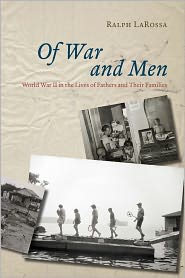 He applied the “Page 99 Test” to his new book, Of War and Men: World War II in the Lives of Fathers and Their Families, and reported the following:
He applied the “Page 99 Test” to his new book, Of War and Men: World War II in the Lives of Fathers and Their Families, and reported the following:Of War and Men tells the story of America's fathers and their families in the throes and aftermath of World War II, covering the period from 1941 to 1960--from the attack on Pearl Harbor to the election of John F. Kennedy. The book digs deep into the terrain of fatherhood and explores the nature and aftereffects of combat, the culture of fear during the Cold War, the ways that fear altered the lives of racial and sexual minorities, and how the Civil Rights Movement affected families both black and white. Overturning some calcified myths, the book also analyzes the impact of suburbanization on fathers and their kids, discovering that living in the suburbs often strengthened their bond. And looking beyond the idealized dad enshrined in TV sitcoms, Of War and Men explores the brutal side of family life in the postwar years.Learn more about Of War and Men at the University of Chicago Press website.
A central theme of the book is that war produces a myriad of effects and that social change proceeds in incremental steps. Thus, in examining the impact of the war, I emphasize not only that the war years were different from the postwar years, but also that wartime and post wartime are not undifferentiated wholes. This may seem obvious when we talk about the war (clearly it had a beginning, a middle, and an end), but the principle also applies to what happened after the war. Although fatherhood between 1945 and 1960 (also known as the fifties) is often talked about as if it were a single historical moment, in actuality it is best understood as a complex of moments. Noteworthy, too, is that when all the moments are closely examined, the moment that is the most traditional, with greater socially constructed distinctions between fatherhood and motherhood, is not the first moment but the last. Contrary to what some scholars have suggested, fatherhood in America did not become more modern in the fifties; it became less.
Here is where the Page 99 test comes into play. The only words on page 99 in Of War and Men are "Part Three." On the face of it, this would seem to belie the notion that the quality of a whole book can be revealed in a single page. If we wanted to give the test the benefit of the doubt, however, we would ask why the book is divided into parts (besides the chapters, which also are "parts"). The answer is connected to the central theme of subperiodization. Of War and Men is divided into parts to underscore the concept of incremental change, with the first two parts devoted to the war (Part One) and its immediate aftermath (Part Two), and the second two parts devoted to the late 1940s and early 1950s (Part Three) and to what happens between 1955 and 1960 (Part Four).
--Marshal Zeringue



